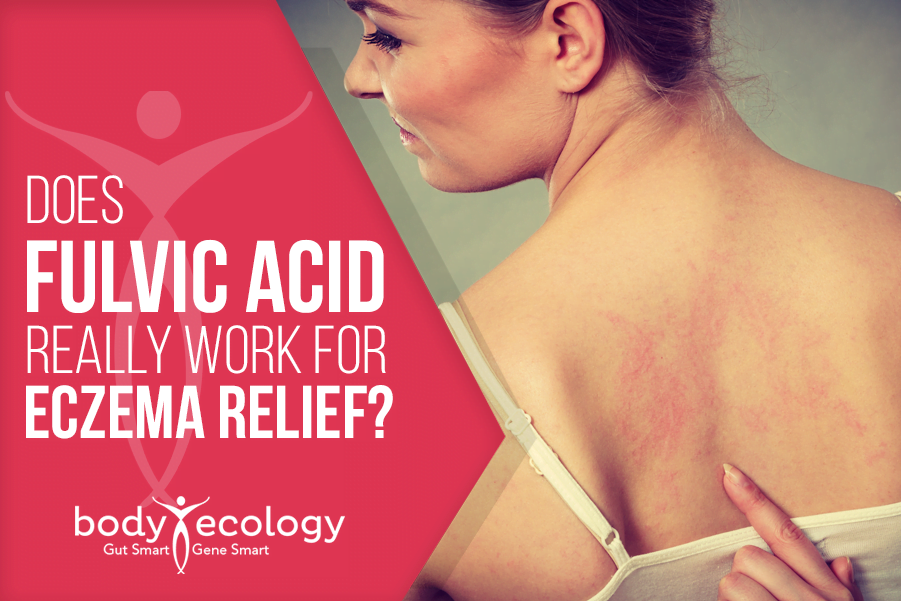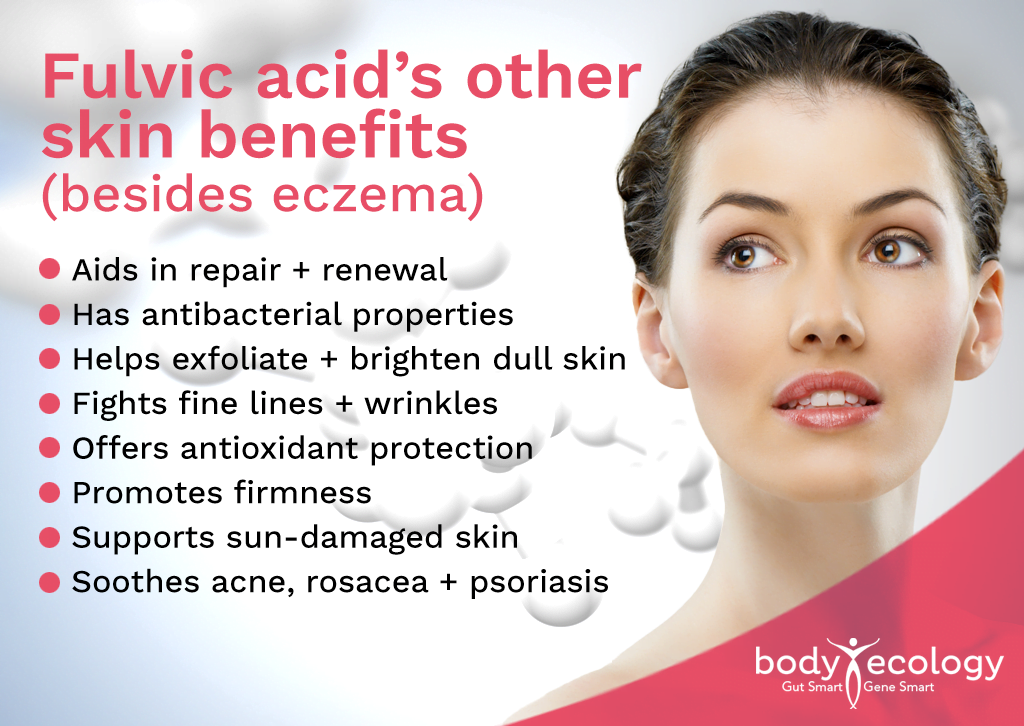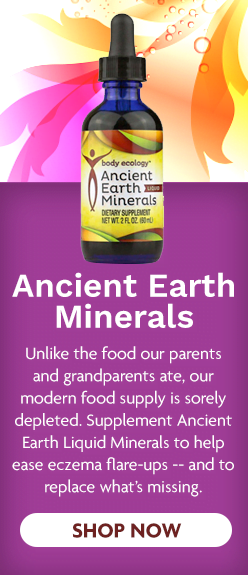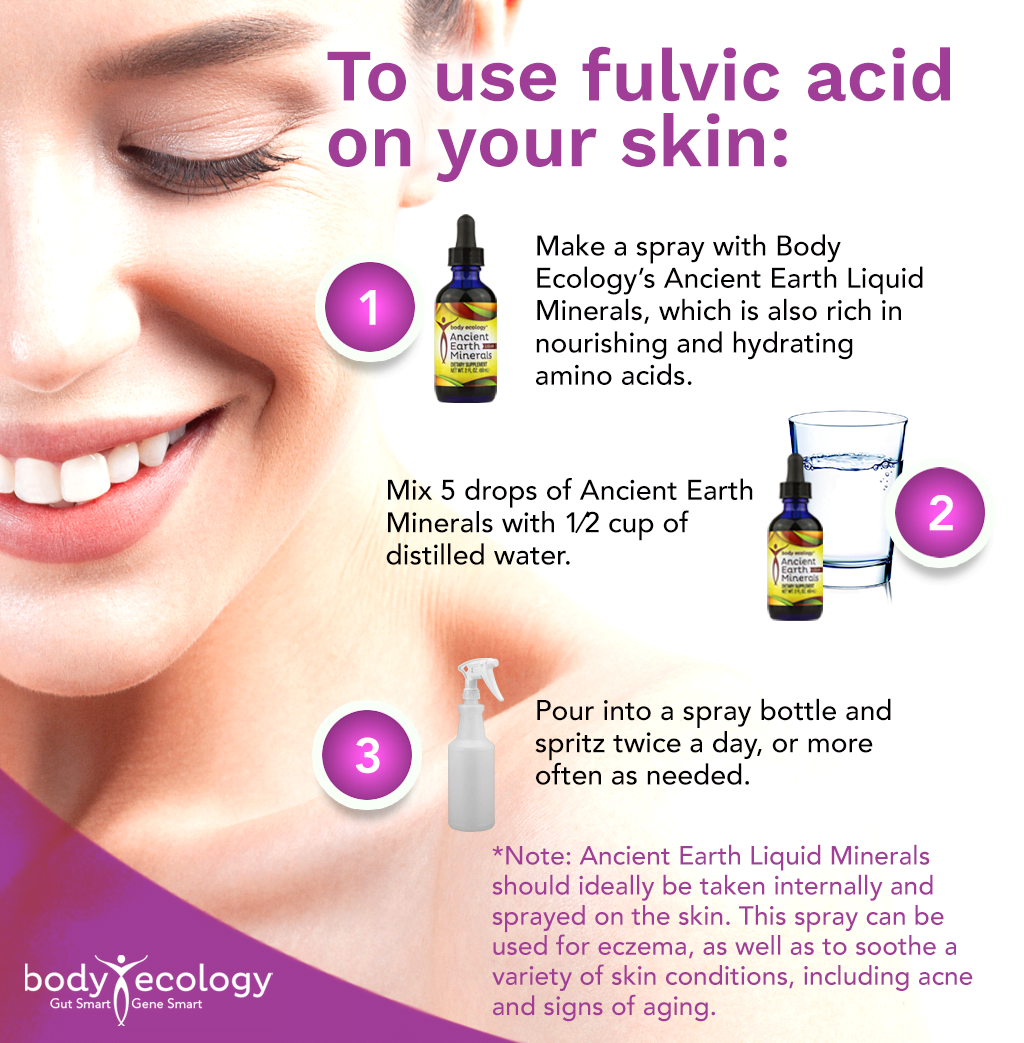
Has your dermatologist told you about this natural eczema remedy?
Fulvic acid is an excellent digestive tonic. There’s evidence that it can help heal the gut, in addition to being traditionally used to support immune function.1,2 Fulvic acid can also help combat oxidative damage and lessen inflammation, which is why dermatologists are investigating its potential as an eczema remedy.3
Can you use fulvic acid to support healthy skin?
And, if so, what’s the best way to apply this mineral-rich substance?
To answer this question, let’s start with the basics — by understanding the functions of fulvic acid:
- Fulvic acid comes from broken-down plant matter in the soil and comprises a group of chemicals including many beneficial minerals.
- It’s known to have several nutraceutical benefits, such as helping to reduce inflammation, support immune function, and exert antimicrobial activity.2,4
- Given the benefits of taking fulvic acid internally — helping to support the digestive system, repair the gut, break down biofilms, and inhibit pathogen growth, etc. — researchers began to consider the potential for fulvic acid to offer health benefits when applied topically.5
In some studies, topical fulvic acids applied to wounds infected with antibiotic-resistant pathogens helped to stimulate immune function and prevent the spread of infection.4 Recognizing the likely benefits of topical fulvic acid, attention has now turned to soothing inflamed skin in conditions like eczema.
Eczema is a difficult skin condition to treat, with recurrent episodes, a systemic component, and vulnerability to often unavoidable external irritants. Treatment is usually in the form of topical glucocorticoids and emollients or with topical calcineurin antagonists (e.g., pimecrolimus or tacrolimus). In some severe cases, systemic immunosuppressive therapy may be used too.
These approaches can offer relief but do little to address underlying mechanisms contributing to eczema. What’s more, they may leave a person more vulnerable to infection and create the conditions for overall poor health.
Taking fulvic acid internally may offer an eczema remedy by addressing intestinal upset and microbial imbalances. Other internal remedies, such as EcoOxyzyme, may also be of benefit by helping to bust through biofilms (which compromise gut health and hinder the absorption of nutrients essential for healthy skin and immune function) and by helping the body to manage inflammation.

We get better together: Follow us on Facebook to join our growing community.
What about applying topical fulvic acid to calm inflamed skin?
Skin pH is an important factor in many conditions:
- The term “acid mantle” was first used by Schade and Marchionini to describe the slightly acidic conditions of the top layer of human skin, with a pH of 4 to 6.6
- This is a result of amino acids, fatty acids, sebum secreted by the sebaceous gland, and lactate excreted from sweat.
- Together, these compounds create a barrier that prevents bacterial colonization.
- The higher the pH of skin, i.e., the more alkaline, the greater the risk of secondary infections.7
- An increase in skin pH (i.e., greater alkalinity) has also been associated with atopic and seborrheic dermatitis.8-10
Because fulvic acid is an acid, it may, therefore, help keep infection at bay. Indeed, naturally-derived fulvic acid has been seen in laboratory studies to have both clear anti-inflammatory properties when applied topically to mice and antimicrobial activity.11 The acidity of fulvic acid also has the additional benefit of helping to relieve skin itching associated with eczema.
This has played out in clinical research involving patients with eczema:
- In one randomized, double-blind, placebo-controlled trial, fulvic acid led to significant relief from erythema (redness) and a reduction in severity of eczema in patients with the skin condition.12
- There were minimal side effects reported, and fulvic acid was well-tolerated.
- Compared to just using an emollient, those using topical fulvic acid had significant skin improvements.
The treatment comprised a carbohydrate-derived fulvic acid concentrated at 3.5 percent, compared to a pH-matched emollient placebo (pH 4.8). Participants applied the creams twice daily to affected areas, along with Epizone A® emollient buffered with acetic acid as needed.
The one reported difference in side effects in this study was minor — a short-lived burning sensation when first applying the fulvic acid (which is common whenever applying liquid minerals topically). Both the patients themselves and the clinicians reported significant benefits from the fulvic acid.
Fulvic acid was also seen in one study to affect histamine levels in skin and to decrease allergic responses on a skin prick test.13 This further suggests that the substance may be beneficial for those with skin sensitivities.
This spray can be used twice a day as needed to help feed and nourish your skin with essential minerals and amino acids. As per the studies outlined above, using fulvic acid topically may also help your skin to maintain a healthy pH, meaning less risk of microbial infection, inflammation, and immune system hypersensitivity.
REFERENCES:
- 1. Winkler J, Ghosh S. Therapeutic Potential of Fulvic Acid in Chronic Inflammatory Diseases and Diabetes. J Diabetes Res. 2018;2018:5391014. Published 2018 Sep 10. doi:10.1155/2018/5391014.
- 2. Sabi, Riaz & Vrey, Pieter & Van Rensburg, Constance. (2012). Carbohydrate-derived Fulvic acid (CHD-FA) inhibits Carrageenan-induced inflammation and enhances wound healing: efficacy and Toxicity study in rats. Drug Development Research. 73. 10.1002/ddr.20445.
- 3. Visser SA. Effect of humic substances on mitochondrial respiration and oxidative phosphorylation. Sci Total Environ. 1987 Apr;62:347-54. doi: 10.1016/0048-9697(87)90521-3. PMID: 2953069.
- 4. Zhao Y, Paderu P, Delmas G, Dolgov E, Lee MH, Senter M, Park S, Leivers S, Perlin DS. Carbohydrate-derived fulvic acid is a highly promising topical agent to enhance healing of wounds infected with drug-resistant pathogens. J Trauma Acute Care Surg. 2015 Oct;79(4 Suppl 2):S121-9. doi: 10.1097/TA.0000000000000737. PMID: 26406424.
- 5. Sherry L, Millhouse E, Lappin DF, Murray C, Culshaw S, Nile CJ, Ramage G. Investigating the biological properties of carbohydrate derived fulvic acid (CHD-FA) as a potential novel therapy for the management of oral biofilm infections. BMC Oral Health. 2013 Sep 24;13:47. doi: 10.1186/1472-6831-13-47. PMID: 24063298; PMCID: PMC3849008.
- 6. Schade H, Marchionini A: Der Säuremantel der Haut. Klin Wochenschr 1928;7:12-14.
- 7. Chikakane K, Takahashi H. Measurement of skin pH and its significance in cutaneous diseases. Clin Dermatol. 1995; 13:299–306.
- 8. Levin OL, Silvers SE. The reaction of the skin and its secretions in eczema. Arch Derm Syphilol. 1932; 25:825–834.
- 9. Fluhr J.W., Elias P.M. Stratum Corneum PH: Formation and Function of the “Acid Mantle” Exog. Dermatol. 2002; 1:163–175. doi: 10.1159/000066140.
- 10. Beare J.M., Cheeseman E.A., Gailey A.A.H., Neill D.W. The pH of the Skin Surface of Children with Seborrhoeic Dermatitis Compared with Unaffected Children. Br. J. Dermatol. 1958; 70:233–241. doi: 10.1111/j.1365-2133.1958.tb13330.x.
- 11. Gandy JJ, Snyman JR, van Rensburg CE. Randomized, parallel-group, double-blind, controlled study to evaluate the efficacy and safety of carbohydrate-derived fulvic acid in topical treatment of eczema. Clin Cosmet Investig Dermatol. 2011;4:145-148. doi:10.2147/CCID.S23110.
- 12. Gandy JJ, Snyman JR, Van Rensburg CE. Randomized, parallel-group, double-blind, controlled study to evaluate the efficacy and safety of carbohydrate-derived fulvic acid in topical treatment of eczema. Clin. Cosmet. Investig. Dermatol, 2011; 4, 145–148. 10.2147/CCID.S23110.
- 13. Gandy JJ, Meeding JP, Snyman JR, van Rensburg CE. Phase 1 clinical study of the acute and subacute safety and proof-of-concept efficacy of carbohydrate-derived fulvic acid. Clin Pharmacol. 2012; 4:7-11. doi:10.2147/CPAA.S25784.










